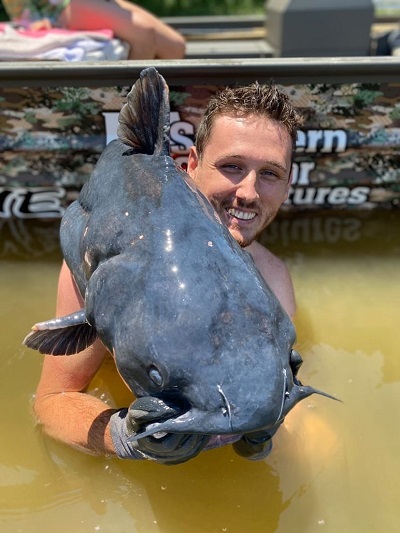The blue catfish (Ictalurus furcatus) is the largest catfish in North America and is a very interesting species in general. In this article, we will take a deep look at this species, its’ anatomy, and its’ behavior.
Blue Catfish (A General Description)
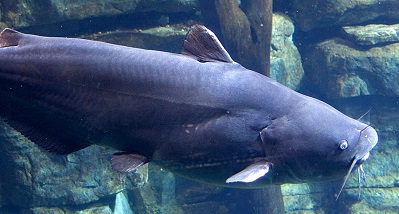
Some distinctive features of the blue catfish are its body shape, color, jaw and fins. (photo credit: Tennessee Aquarium – tnaqua.org).
Blue catfish have a blue-gray coloration and have wide and stocky bodies.
One of the key physical identifiers of a blue cat is a distinct and noticeable dorsal hump when it becomes a mature fish, which is a good anatomical feature to distinguish a blue catfish from a channel catfish.

The tail of the blue catfish has a deeply notched fork.
Other catfish in North America have a lower protruding jaw, but blues have an upper protruding jaw which is another observation you can make to distinguish between catfish species.
The blue catfish features barbels, or “whiskers,” which are present on all catfish species in North America.
The number of anal fin rays is also different from that of a channel cat. Blue catfish anal fin rays will vary from 30-36 rays, while channel catfish only feature between 25-29 rays.

Blue catfish (pictured here) are sometimes mistaken for channel catfish (below picture) as a result of having a similar appearance in the bodies of water where both are found. This occurs more often when trying to determine the species of the fish when they are juveniles.
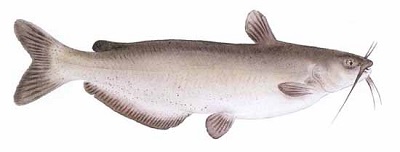
-
Sale!

Put a Hook N1™ UPF30 Marlin Performance Fishing Shirt (White)
Original price was: $34.99.$9.00Current price is: $9.00. Select options This product has multiple variants. The options may be chosen on the product page -

N1 Outdoors® Block Logo Tee
$22.99 – $24.99 Select options This product has multiple variants. The options may be chosen on the product page -
Sale!

Put A Hand N1™ Catfish Noodling Tee (various colors)
$9.00 Select options This product has multiple variants. The options may be chosen on the product page
Where Are Blue Catfish Located?
The most well-known waters the blue catfish calls home would be the Mississippi river system and its branches and tributaries, which include the Arkansas, Missouri, Tennessee, and Ohio rivers, along with their tributaries and nearby smaller bodies of water.
The rivers listed above aren’t the only rivers to hold native populations, other rivers, such as the Rio Grande river and the Des Moines river in Southern Iowa, also have prominent populations of blue cats.

Interestingly, the blue catfish range extends farther south than most people in the United States are aware of, farther than any other catfish prominently found in North America, and extends throughout the Gulf coast of Mexico and continues south to the countries of Guatemala and Belize in Central America.
Blue catfish have also been introduced into many bodies of water outside where they are found historically, expanding their range and giving anglers more opportunities to catch the fish.
Blue Catfish Diet
The blue catfish has a diet comparable to all catfish species, and they will feed on various species such as frogs, mussels, crayfish, small to medium-sized fish like bluegills and bullheads, minnows, and other aquatic and semi-aquatic prey like small land mammals and birds.
Blues are opportunistic feeders like all catfish and eat virtually any animal or edible animal parts that is the appropriate size.
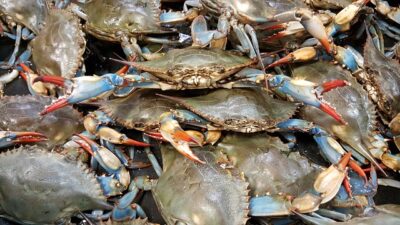
One interesting food choice… The blue catfish also feeds on the blue crab, a valuable species for the economy around the Chesapeake Bay. Blue crabs are the most valuable species in economic fisheries for seafood, and the number of blue crabs has suffered due to the introduction of blue catfish.
Blue cats prefer easy meals, such as animals that are already dead or wounded, this is the main reason the fish will gather near any hydroelectric dams to feed on animals and fish that have been pulled through the spillways.
Anglers who fish for blue cats favor using live bait like bullheads or cut bait from various fish species like shad, skipjack, bullhead, bluegills, and others. Some anglers also use various other types of bait, like chicken liver or a mixed catfish bait recipe that is thick, smelly, and has a consistency of something like peanut butter.
How Big Do Blue Catfish Get?
According to NOAA Fisheries, mature blue catfish will typically be less than two feet long. However, blue catfish can grow to be even 5 feet long and weigh in over 100 pounds!
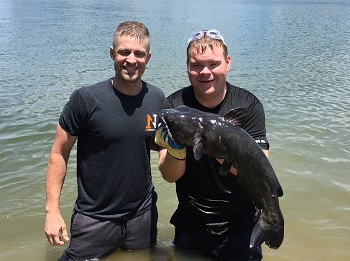
Most adult blue cats, like this one pictured, tend to be less than 24 inches in length, but they can get huge… over 100 pounds!
Invasive Species
Blue catfish is a very adaptable species that can tolerate a wide range of environments, which means that in some places where they have been intentionally or accidentally introduced, they can have negative effects on the ecosystem.
They can even tolerate water with salinity levels, such as tributaries and brackish water areas leading to the ocean.
In certain waters in Virginia, the blue catfish was purposely introduced in the 1970s, the population quickly exploded and has caused issues with the native species to this day.
In the tidal rivers leading to the Chesapeake Bay, the blue catfish has become the dominant predatory species, out-competing other species native to the waters.
Small fish species like alewives, anadromous shad species, and blueback herring have seen massive drops in numbers due to predation from the blue catfish.
There is a bit of a silver lining to the blue catfish issues in Virginia waterways, as the catfish also feed on the Asian clam and hydrilla, both of which are also invasive species. While they help keep these invasive species in check, it’s difficult to say whether this outweighs the effects the fish has on native species.
Fishing for the Blue Catfish
Like all fish, the blue catfish has preferences in its habitat, and to successfully catch them, you have to be in the right place at the right time.
As mentioned earlier, your best choices for bait selection will typically be live or cut bait, with cut bait being the most prominent selection. When fishing in locations holding blue cats, cut bait utilizing herring, shad, bullheads, bluegills, or manhaden is sure to seal the deal on one!
Commercially produced stink bait, chicken liver, and other smelly types of bait are the favorite of many anglers, and some swear by their effectiveness over live or cut bait in certain fishing situations.
Blues like deep holes in the river systems they inhabit, so be sure to search out any holes that are 15-25 feet in depth, along with any depressions in otherwise flat and shallow areas that are in the 10-12 foot depth range.
If there is timber present on the edges of holes or in the hole itself, be sure to add it to the top of your hit list, and even areas with rocks, rip rap, and boulders can consistently hold big blues. Maybe you can put a hook N1!
It’s a great idea to run as many rods as you legally can for blue cats, covering a fairly wide area and running a variety of bait options.
Not only does having multiple lines help you contact more fish, but running different bait options not only allows you to figure out what the fish are keyed into on any given day, but you can also adjust your offerings based on what they want.
Final Thoughts
Blue catfish can get huge and are vicious predators in the waters they inhabit. Understanding the fish, its environment, behavior, and anatomy can help you be consistent on the water when pursuing them, and the results can be epic.

